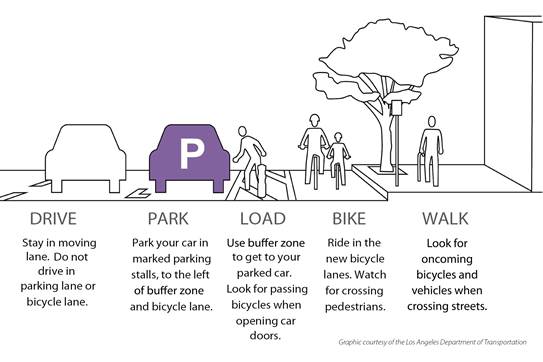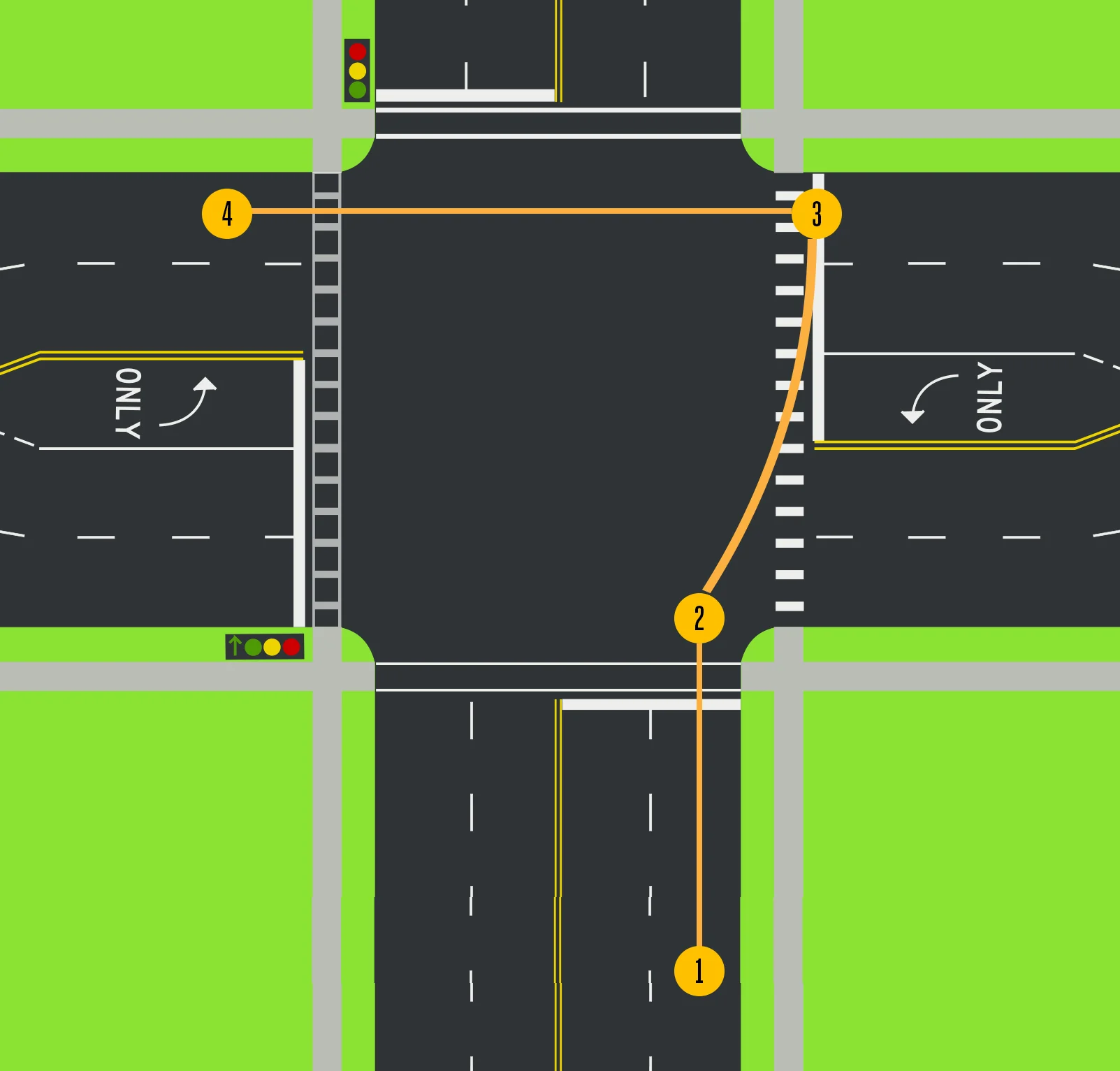Browns Valley Road/First Street in Napa City was recently repaved and restriped to include many safety improvements for drivers, bicyclists and pedestrians, including parking-protected bike lanes. While this design is not a new concept and has been widely implemented, it is new to the City of Napa. Browse the FAQ below, and check out the City project website for more information.
Why did the City change the street design of Browns Valley Road?
Browns Valley Road has been identified in many transportation plans for safety improvements, including the City of Napa’s Local Roadway Safety Plan where Browns Valley Road was identified as part of the city’s high-injury network. This means it is one of a handful of city streets that experiences a high number and high severity of traffic collisions. When the City did a speed survey of the road in 2022, they found it had a traffic crash rate three times the statewide average. So when it was time for the City to repave Browns Valley Road, they changed the street design to improve safety for all road users, including narrowing lanes to slow down traffic, adding pedestrian safety upgrades, and switching to parking-protected bike lanes.
What are parking-protected bike lanes?
Parking-protected bike lanes are a type of protected bike lanes, which means there is a physical separator between the bike lane and vehicle travel lane. In the case of parking-protected bike lanes, that physical barrier is parked cars.

Why use parked cars as the physical barrier?
Using the parking lane as the physical barrier for protected bike lanes allows streets to keep their on-street parking when a protected bike lane is installed. Other physical barriers, like posts and curbs, can also be used to separate the bike lane from the vehicle travel lane; however, because these barriers would block cars from parking curbside, they often require removal of on-street parking.
What is the benefit of parking-protected bike lanes?
Compared to regular bike lanes, protected bike lanes can reduce vehicle-bicyclist crashes by over 50% and are associated with improved safety for all road users, not just people on bikes. They separate bicyclists from moving traffic, make biking safer and more comfortable for a wider range of bicyclists, and have been associated with higher rates of bicycling, which is good for community health and reducing traffic. They also maintain on-street parking for vehicles.
But weren’t the old bike lanes fine?
For some people, the old bike lanes worked well enough. But when looking at the vehicle speeds and volumes on Browns Valley Road, bikeway selection guides like the one provided by the Federal Highway Administration say that protected bike lanes are the appropriate kind of bike lane for a safe and comfortable bike network.
How will I/my passengers get out of the car on the left side?
Just like on any other street where car parking is next to the travel lane – you’ll look out of your car window and check your rearview mirror before exiting your vehicle. You can help children exit from the left side, or have them exit from the right side.
If I’m biking, how will I make a left turn?
To make a left turn, you have several options. 1) Leave the protected bike lane in advance of your left turn and ride like a vehicle to merge left and position yourself properly for a left turn, sometimes as much as a block early. There are many gaps in the ‘protection’ of the bike lane where you can leave the lane. 2) Make a two-stage left turn. For this, you stay in the protected bike lane and proceed straight into the intersection of the street where you want to make a left turn, and position yourself on the far side of the intersection just outside of the bike lane, either to the right or left as is safe. Then, reposition yourself to the left and proceed across the cross street when safe to do so. (See diagram below). (Adapted from Bike East Bay).

Diagram from Pure Cycles.
If I’m biking, will I get "doored"?
“Dooring” describes when a car door opens in front of a moving bicyclist, causing a crash. Parking protected bike lanes provide a painted buffer space between the car and the bike lane, so if someone opens the car door without looking, the door will open primarily within that buffer space instead of the bike lane. This actually reduces the risk of dooring compared to normal bike lanes, which have no painted buffer between parked cars and the bike lane. There is room for a bicyclist and a fully open door given the buffer and lane width, and parking protected bike lanes prevent cyclists from reflexively swerving into the vehicle lane to dodge the door, which in turn reduces their chances of a serious collision. As well, around half of all vehicle trips are single-occupancy, so the risk of dooring on the passenger side of a vehicle is far reduced.
How will drivers see bicyclists at driveways and intersections?
Following standard designs, there are clear zones next to driveways and intersections where parking is prohibited, like how a red zone on the curb works, so that vehicles turning at intersections and driveways can see bicyclists. Drivers who are turning into driveways and intersections should also slow down when turning and be conscientious to check for bicyclists in the bike lane; this is similar to checking for pedestrians, scooters, and children biking on the sidewalk on any other street. Bicyclists should also be watchful for right-turning drivers at driveways and intersections as well.
Where will I put my trash bins on trash day?
Trash bins go in the parking lane, which is the same location they were put before the road design change. Do not place trash bins in the bike lane – this is illegal and dangerous. It forces bicyclists to move out of the bike lane. You may also place trash bins in the buffer space (the hash-marked paint between the bike lane and the travel lane) if there is no parking lane.
Did parking-protected bike lanes cost the City a lot of money?
Even though the street design looks very different, the parking-protected bike lanes are relatively inexpensive, because they are created out of just paint. Since the street would need to be repainted after the repaving anyway, this did not introduce a significant new cost. The most expensive part of this project was repaving the asphalt of the street itself. The project was funded by Measure T/U, a local sales tax.
Do bicyclists even pay road taxes?
Yes. Most local roads in North America—the ones we bike on—are funded through general taxes like property, income, and sales tax. These aren’t user fees. That means whether you drive or not, you help pay for roads.
Plus, most cyclists also drive and pay vehicle registration and gas taxes. Many cyclists are subsidizing others’ driving lifestyle while creating less wear-and-tear, needing less space, and reducing emissions. (adapted from Momentum Mag).
What is that green strip on eastbound 1st St. at the intersection with Freeway Drive?
The green strip is called a “bike box,” and it is the first to be installed in Napa County. Bike boxes are designated areas at the front of traffic lanes that provide people on bikes with safe and visible ways to get ahead of queuing traffic and to position themselves for a left turn (NACTO). See below for a visual explanation. Bike boxes help bicyclists make left turns and increase their visibility, reduce bicyclist collisions with right-turning vehicles, reduce vehicle encroachment in the crosswalk, and group bicyclists together to clear intersections quickly.

Image from City of Bloomington.


